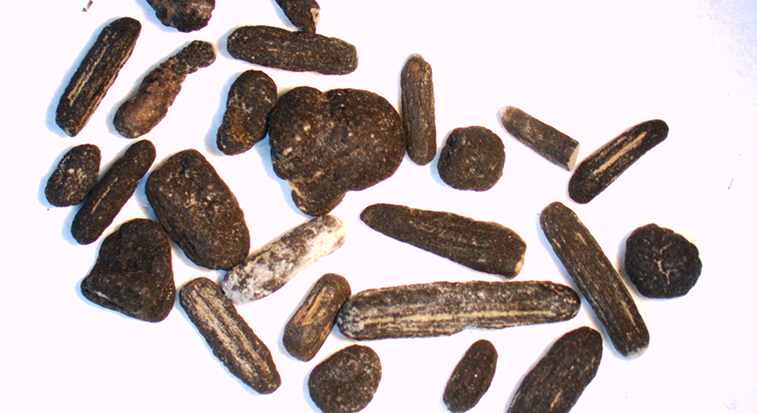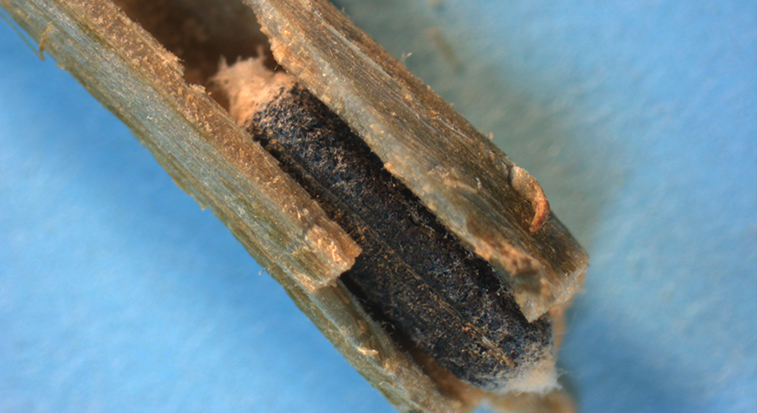Paddock selection for broadleaf crops in 2017
by Phil Bowden (Pulse Australia), Don McCaffery (NSW DPI) and Kurt Lindbeck (NSW DPI)
Featured image: Early sclerotinia stem rot lesion development on canola (Kurt Lindbeck, NSW DPI).
With the harvest finally over, attention now turns to fine-tuning planned crop rotations and making paddock selections that take into account the higher disease pressure in many crops in 2016, due to prolonged wet conditions in winter and spring.
In particular, sclerotinia stem rot, a common fungal disease of broadleaf crops such as canola, that has become more prevalent in chickpeas and lentils, had an impact on crop yields in many regions and must be considered when selecting paddocks for broadleaf crops in 2017 season and beyond.
Sclerotinia sclerotiorum, the fungus that causes sclerotinia stem rot, has a wide host range including many common broadleaf weed species and nearly all the broadleaf crops. Ideal conditions last season will have boosted inoculum levels in paddocks growing these crops and weeds. The main drivers of disease severity are the frequency and amount of late winter and spring rainfall, the length of crop flowering and how frequently a broadleaf crop has been grown in each paddock.
The survival structures of the pathogen are known as ‘sclerotes’ and can remain viable in the soil for as long as ten years. Multiple rainfall events in late winter and spring in 2016 triggered germination of sclerotia and the subsequent release of air-borne spores, which infected flower petals and other plant parts, such as old leaves. Continued wet conditions allowed infected petals to cause stem lesions, and return more sclerotia to the soil. Direct infection of young plants can also occur, but is less common than petal and stem infection.

Sclerotes from North Star chickpea sample showing irregular types typical of S. sclerotiorum with the atypical cylindrical types. Photo: Gail Chiplin NSW DPI Tamworth
Breaking the disease cycle involves careful planning, particularly for high risk paddocks, including:
- seed cleaning
- variety selection and sowing time
- foliar fungicide program
- crop rotation sequence
- soil and paddock drainage.
Seed cleaning
Sclerotes can end up in the header bin in seed retained to sow following crops. Grade oilseed and pulse seed used for sowing to remove sclerotes. Also apply a registered fungicide seed dressing at the same time to protect seedlings from seed-borne disease.
Variety selection and sowing time
There are no Sclerotinia resistant crop varieties but variety selection is still important because the timing and duration of flowering are factors in disease development.
The timing of the commencement of flowering can significantly influence the susceptibility of pulse and oilseed crops to Sclerotinia infection. Crops that commence flowering early (late June–July) are at a significantly higher disease risk. Flowers are emerging at a time of ascospore release from sclerotia and extended periods of leaf wetness, which are ideal for infection. Early flowering also exposes the crop to multiple infection events and more opportunities for the disease to develop to damaging levels.
Follow the recommended sowing times for canola and pulse varieties best suited to your district. These recommended sowing times have been developed to optimise yield and minimise disease. Generally, early sown pulse crops are more prone to disease and frost injury. Early sowing exposes field peas to blackspot and bacterial blight, lupins are more prone to frost injury and chickpeas are more susceptible to sclerotinia stem rot.
Foliar fungicide program
Use of registered foliar fungicides to manage sclerotinia stem rot can assist in reducing the disease, but timing is critical for success. The recommendation for canola is to apply fungicide at 20–30% bloom, when 15–20 flowers are open along the main stem. Fungicides are only effective for about three weeks, so timing is important to provide crop protection when the spores are released from the soil. Rainfall events during flowering can affect the result, so applications of fungicide need to be carefully planned. Good coverage of the protectant fungicides on plant stems is required. For best results, use higher water rates and droplet sizes that will penetrate into the canopy.
Crop rotation sequences
The rotation sequence can help reduce the overall amount of inoculum in a paddock. With Sclerotinia being such a widely hosted pathogen and with the sclerotes able to survive for up to 10 years in soil, getting a non-host crop or a less susceptible variety into the rotation can be one of the most effective cultural controls.
Inoculum levels can build up under some of the close cropped rotation sequences (e.g. canola–wheat–canola). To minimise canola diseases such as blackleg and sclerotinia stem rot it is important to maintain a distance of at least 500 m between the canola crop and the stubble of canola or other susceptible crops. Many foliar pathogens of pulse crops also survive in old stubble residue, ready to release spores the following year to infect emerging crops. Avoid sowing new season pulse crops adjacent to last season’s pulse stubble.
A conflicting issue with rotations for disease management has been the use of double breaks with canola and pulses for herbicide resistant weed control. Herbicide resistant weeds are the biggest problem in most cropping areas so alternate cultural controls have become more important, but disease inoculum often builds up when susceptible crops are grown in sequence. This is particularly important when conditions for disease are favourable, as witnessed in many regions in 2016.
Canola is the largest break crop for cereal crop weed management because of the numerous herbicide choices, but seedling canola crops do not compete well with some weed species, especially from within the Brassica family, that are all potential hosts for Sclerotinia. Pulse crops also are a good choice when managing weeds as they can either be sprayed with selective grass herbicides or green or brown manured prior to weed seed heads appearing, but again are susceptible to Sclerotinia.
The choice of rotation sequence crops is important and should be flexible enough to take into account the paddock history of weed species and resistance status, disease and insect pests, economics of the crop, and the benefits that crop will bring to future uses of the paddock.
Canola and pulse crops provide an opportunity to use different chemistry for weed control, which may assist in the management of herbicide resistance, and care needs to be taken when considering how diseases will affect the crops both in the current season and the future build-up of pathogen inoculum.

Sclerotinia sclerote forming inside chickpea stem at Pallamallawa (TR8867) resulting in atypical, cylindrical shape. Photo: Gail Chiplin NSW DPI Tamworth
Soil and paddock drainage
Another paddock selection consideration is ensuring adequate soil and paddock drainage to avoid waterlogging. Most pulse and oilseed crop species have poor tolerance to waterlogging so be aware of soil types, paddock topography and the presence of hardpans that can promote waterlogging. Poor drainage exposes these crops to increased root rot diseases, such as phytophthora root rot, or premature crop death due to anaerobic conditions in the root zone.
For more information:
- Clearing confusion over sclerotes in chickpea and lentil crops during 2016 harvest
- Chickpea Integrated Disease Management strategies
- Sclerotinia stem rot in canola (GRDC factsheet)
- Australian Oilseeds Federation


